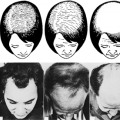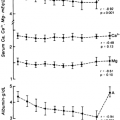CLINICAL COURSE
Part of “CHAPTER 43 – ENDOCRINE OPHTHALMOPATHY“
Retraction of the upper eyelids is the most important clinical clue and produces a triad that is nearly pathognomonic of
endocrine ophthalmopathy: widened palpebral fissures, lid lag on downward gaze, and infrequent blinking (see Fig. 43-1A).
endocrine ophthalmopathy: widened palpebral fissures, lid lag on downward gaze, and infrequent blinking (see Fig. 43-1A).
Normally, the upper lid covers the upper limbus so that the free border rests at the upper edge of the pupil. Many factors change this relation, and care must be taken in assuming that the upper lid retraction is abnormal. Lid retraction exists if, when the eyes are directed horizontally forward without staring, a band of white sclera is seen above the iris. Because of the cosmetic changes created by this phenomenon, concern over appearance usually is the presenting complaint. In some instances, only one eyelid is retracted, and the patient may complain that the other upper lid is drooped. Lid lag accompanies the retraction of the upper eyelid and is manifested as a failure of the lid to accompany the descent of the globe on downward gaze, with the appearance of a white band of sclera above the upper limbus.
These phenomena (lid retraction and lid lag) give the impression of exophthalmos, but in the early stages, usually little or no measurable proptosis is present. In the mild form of orbital involvement, as the process continues, actual exophthalmos may occur. The forward position of the globe is appreciated best by direct measurements but can be suggested by retraction of the lower lid.
Stay updated, free articles. Join our Telegram channel

Full access? Get Clinical Tree





